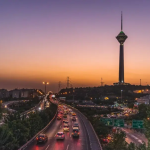Saint Sarkis Church, also known as the Church of Saint Sarkis the Warrior, is an Armenian Apostolic church located in the heart of Tehran, Iran. Built in the 1970s, the church is one of the most prominent landmarks of the Armenian community in Iran and a symbol of their rich cultural heritage.
Tracing the Roots of Saint Sarkis Church: A Historical Overview
The history of Armenians in Iran dates back to ancient times, with the first recorded Armenian settlement in Iran dating back to the 6th century BC. Over the centuries, Armenians have played an important role in shaping the culture and history of Iran, and their influence can be seen in the country’s art, music, literature, and architecture.
One of the most significant examples of Armenian architecture in Iran is Saint Sarkis Church. The church was built in the 1970s by the Armenian community of Tehran, which had been growing steadily since the early 20th century. The church was designed by the renowned Armenian architect, Sarkis Balyan, who also designed many other notable buildings in Iran, including the famous mansion of the Qajar-era princess, Shams Pahlavi.

The Architecture of Saint Sarkis Church
The Saint Sarkis Holy Church in Tehran is the largest church in the city. It has a basilica plan with a single nave and is built on a low platform. The church has a cross-shaped plan inside, with the houses on either side of the altar in the eastern part of the building and the main entrance hall on the western side. The exterior walls are made of white marble, while the interior walls and ceiling are covered with plaster.
The architect, Aram Aftandilian, mixed the architectural styles of the Middle Ages and the new era of Armenian architecture and made bold changes to create a dome that appears to be suspended in the air without any support on the roof. This is unusual for single-nave churches, which usually do not have a dome due to the weight of the roof. However, Aftandilian managed to build a great dome on Saint Sarkis Holy Church.
The altar of the church is semi-circular and has two sacristies on either side. The upper walls of the altar and its two sides are covered with wall paintings depicting themes from the Bible. The church courtyard can be divided into three parts, with the central part being wider than the eastern and western parts, and the dome is located in this part of the building.
The main entrance has a portal with the architectural style of Armenian churches from the 4th and 5th centuries AD, and there is a balcony above it where the choir sings religious hymns. The church has two bell towers, which are located on either side of the western hallway entrance and above the two entrances to the building. They are tower-shaped with a four-sided plan and have eight-sided domes at the top. Take part in our guided tours to Saint Sarkis Church, providing you a nice visit with a deeper understanding of this church’s history and architecture.
Celebrating Armenian Heritage: The Role of Saint Sarkis Church
Saint Sarkis Church is an important religious center for the Armenian community in Tehran and throughout Iran. The church is dedicated to Saint Sarkis the Warrior, who is believed to have lived in the 4th century AD and is revered as a saint by both Armenians and Syrians. Saint Sarkis is known for his bravery and strength and is believed to have protected the Armenian people from their enemies.
In addition to its religious significance, Saint Sarkis Church also serves as a cultural and social center for the Armenian community in Iran. The church hosts a variety of events and activities throughout the year, including concerts, lectures, and cultural festivals.
Saint Sarkis Holy Church; The Memorial of the Armenian Genocide
The Memorial of the Armenian Genocide in the Saint Sarkis Holy Church is made of white marble and stands at a height of 3.50 meters on a base of the same stone. There is a plaque on the base with inscriptions in Persian Nastaliq script above and Armenian script below, which reads “In memory of the martyrs of Armenians” and “24 April 1915” respectively. The memorial was unveiled on April 23, 1973, on the 58th anniversary of the Armenian Genocide.
The memorial is designed with three stone pieces and the cross symbol on the columns represents the resurrection of Christ and is a sign of martyrdom and uprising. It signifies that despite the massacres, displacement, and dispersion, the Armenian people were able to establish an independent Armenian government in 1918 after enduring centuries of foreign domination. Other symbols on the facade of the memorial represent the spirit of freedom, stability, adherence to religion and faith, and the belief in the triumph of truth and justice.
Last word
Saint Sarkis Church is a unique and important landmark in Iran and a testament to the rich cultural heritage of the Armenian community. Its blend of traditional Armenian and modern architectural styles, combined with its religious and cultural significance, make it a truly remarkable site. Despite the challenges it has faced over the years, the church stands as a symbol of the resilience and perseverance of the Armenian people. It is a testament to the importance of preserving cultural heritage, and a reminder of the important role that cultural landmarks play in shaping our understanding of history and identity.
Let us know your ideas and comments about this church in the comment box below, we will be happy to hear from you!


















